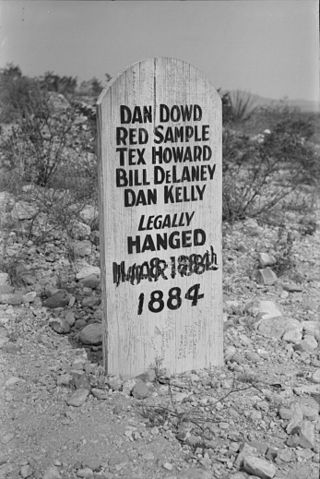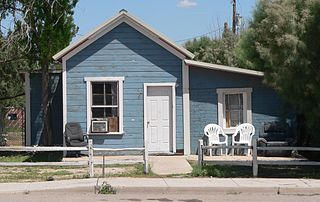
Cochise County is a county in the southeastern corner of the U.S. state of Arizona. It is named after Cochise, a Chiricahua Apache who was a key war leader during the Apache Wars.

Bisbee is a city in and the county seat of Cochise County in southeastern Arizona, United States. It is 92 miles (148 km) southeast of Tucson and 11 miles (18 km) north of the Mexican border. According to the 2020 census, the population of the town was 4,923, down from 5,575 in the 2010 census.

Douglas is a city in Cochise County, Arizona, United States that lies in the north-west to south-east running Sulphur Springs Valley. Douglas has a border crossing with Mexico at Agua Prieta and a history of mining.

Holbrook is a city in Navajo County, Arizona, United States. According to the 2010 census, the population of the city was 5,053. The city is the county seat of Navajo County.

Pete Spence was a small-time criminal known for his association with outlaw Cowboys Frank and Tom McLaury, and Ike and Billy Clanton, of Tombstone, Arizona Territory. Spence was also a suspect in the assassination of Morgan Earp. His wife Marietta Duarte testified that Spence and several friends had talked about killing Morgan, but the judge ruled her testimony inadmissible. Spence was first suspected of robbery in 1878 in Goliad County, Texas. He was suspected of stealing mules and later a suspect in a stagecoach robbery outside Bisbee, Arizona. While a deputy sheriff, he pistol-whipped and killed a man for which he served 18 months of a five-year term before the governor pardoned him.

The Bisbee Deportation was the illegal kidnapping and deportation of about 1,300 striking mine workers, their supporters, and citizen bystanders by 2,000 members of a deputized posse, who arrested them beginning on July 12, 1917, in Bisbee, Arizona. The action was orchestrated by Phelps Dodge, the major mining company in the area, which provided lists of workers and others who were to be arrested to the Cochise County sheriff, Harry C. Wheeler. Those arrested were taken to a local baseball park before being loaded onto cattle cars and deported 200 miles (320 km) to Tres Hermanas in New Mexico. The 16-hour journey was through desert without food and with little water. Once unloaded, the deportees, most without money or transportation, were warned against returning to Bisbee. The US government soon brought in members of the US Army to assist with relocating the deportees to Columbus, New Mexico.

Tombstone Courthouse State Historic Park is a state park of Arizona in the United States. Located in Tombstone, the park preserves the original Cochise County courthouse. The two-story building, constructed in 1882 in the Victorian style, is laid out in the shape of a cross and once contained various county offices, including those of the sheriff, recorder, treasurer, and the Board of Supervisors as well as courtrooms and a jail. Inside, the courthouse contains a museum with numerous artifacts from the town's history while outside, a replica gallows has been constructed in the courtyard to mark the spot where seven men were hanged for various crimes. The park was one of the first to be designated as a state park and in 1959 was the first to open following the 1957 establishment of the Arizona State Parks Board.

Harry Cornwall Wheeler was an Arizona lawman who was the third captain of the Arizona Rangers, as well as the sheriff of Cochise County, serving from 1912 into 1918. He is known as the lead figure in the illegal mass kidnapping and deportation of some 1200 miners and family members, many of them immigrants, from Bisbee, Arizona to New Mexico in 1917. Beginning on July 12, 1917, he took total control of the town of Bisbee, controlling access and running kangaroo courts that deported numerous people.

The Bisbee massacre occurred in Bisbee, Arizona, on December 8, 1883, when six outlaws who were part of the Cochise County Cowboys robbed a general store. Believing the general store's safe contained a mining payroll of $7,000, they timed the robbery incorrectly and were only able to steal between $800 and $3,000, along with a gold watch and jewelry. During the robbery, members of the gang killed five people, including a lawman and a pregnant woman. Six men were convicted of the robbery and murders. John Heath, who was accused of organizing the robbery, was tried separately and sentenced to life in prison. The other five men were convicted of murder and sentenced to hang.

The Bisbee Riot, or the Battle of Brewery Gulch, occurred on July 3, 1919, between the black Buffalo Soldiers of the 10th Cavalry and members of local police forces in Bisbee, Arizona.

The Benson Railroad Historic District is an area of Benson, Arizona, located near the site of a former passenger and freight depot. The area contains 16 structures, 11 buildings and 5 outbuildings, although the outbuildings are not considered contributing structures to the historic district.

The John H. Norton and Company Store is an historic structure in Willcox, Arizona. Built circa 1880, it was added to the National Register of Historic Places in 1983.














